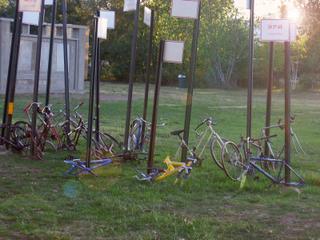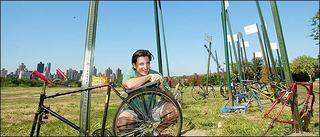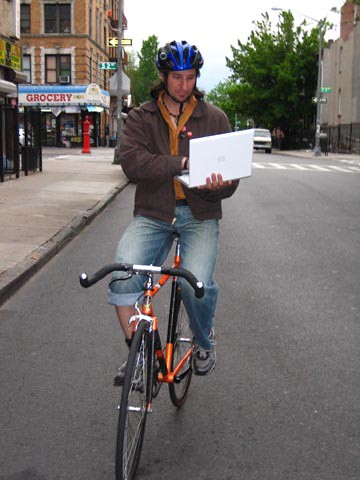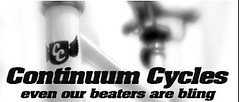So they are fixing the bumps

So we took another multiple borough trek today showing a friend from out of town our bike-friendly city. We started our journey across the Williamsburg Bridge and sure enough, on the Manhattan side, the down ramp, there was construction going on to fix the bumps. The construction workers were joking with us as we passed by saying, "much better, huh?" They hammered away and waited as cyclists and skaters passed over the bumps. Victory! All we needed was a few accident injuries and a tough fight by transportation alternatives to reduce the size of these ridiculous traffic obstructions. I took a few more pictures and one of the DOT workers said, "no pictures, no pictures!" Why? Are you some famous movie star? You should be proud of the work your doing, making the bridge more accessible for the people who need and use alternative forms of transportation.


Then we rode up the West side bike path to go to the African American parde in Harlem. Folks up there seemed most excited by Al Sharpton holding hands with Mayor hopeful Freddy Ferrer.

It was kind of a weird parade. Not very well attended. People did get very excited when the Hot97 float came by anchored by 2 hummers. Then we rode to the East Side for the Mexican independence parade. Nice Bikes.
 Lowrider, get a little higher!!
Lowrider, get a little higher!! Nice Meat!!
Nice Meat!! Then it was time to go back to Brooklyn and we wanted to take the 59th Street bridge. I really hate using 2nd Ave cause of all the traffic. So we went across town over to the FDR and went across a footbridge. There is a path along the East River and then we took the bridge to Randalls Island.
Then it was time to go back to Brooklyn and we wanted to take the 59th Street bridge. I really hate using 2nd Ave cause of all the traffic. So we went across town over to the FDR and went across a footbridge. There is a path along the East River and then we took the bridge to Randalls Island. This is a really nice ride. Then it was over the Triborough and into Queens. Here we saw the bikes on poles at Socrates Sculture Garden.
This is a really nice ride. Then it was over the Triborough and into Queens. Here we saw the bikes on poles at Socrates Sculture Garden. 
Holy shit, that's my bike from 1995! I didn't abandon that, I was just storing it on that pole. Now it's art?
Here is the article in the NYTimes.
article on bike art
 Photo of the artists David Shapiro, with the bicycles he found almost beyond redemption.
Photo of the artists David Shapiro, with the bicycles he found almost beyond redemption.Photo taken by: Ruby Washington, NYtimes
article written by: Corey Kigannon, September 12, 2005
Where do all the old bicycles go: those twisted, rusted, fragmented remnants of freewheeling happiness that are chained to poles and left for dead on New York City streets?
A group of them, at least, have been given second acts as objets d'art by a New York-based artist who found about 100 bikes on city sidewalks this summer and took them to his own Island of Lost Bicycles in Queens.
In an emancipation crusade that involved cutting through Master locks and Kryptonite chains, the artist, David Shapiro, liberated abandoned bicycles from sidewalk purgatory and turned them into sculptures at the Socrates Sculpture Park, a rugged stretch of grass and trees on the East River in Long Island City.
Actually, the bikes are still captives of signposts. Mr. Shapiro, 41, attached them to poles he sunk into the park's grassy expanse. The show, which he calls "Left for Dead," opened at the sculpture park on Saturday, along with nine other exhibitions by other artists.
Leaning against poles are cheap bicycles mangled like pretzels, and high-performance ones with expensive frames. All were found stripped of most parts. And all had been left for at least two weeks.
Mr. Shapiro attached the bikes to posts that resemble city parking signs, each bearing the location of the bike when it was rescued and the date it was salvaged. He put a shiny aluminum tag on each bike bearing the name of the work of art it had become.
A tortured turquoise bike he removed at 54 Canal Street on July 13 was named Turq. Bumblebee is a mountain bike frame wrapped with bright yellow duct tape that was found at 99 Delancey Street. Roadmaster was found at 58 Canal Street on July 13: a dirty, black, weathered Roadmaster bike bereft of its back wheel and seat. The black Schwinn clipped from 204 South Fourth Street in Williamsburg is so twisted and gnarled that Mr. Shapiro named it "Double Pretzel."
"This one is called Handles," Mr. Shapiro said, running his hands along a shabby black Savoy, its plastic handles still spiffy.
For the exhibit, he separated the bicycles into seven groups based on the neighborhoods where they were found. He collected most of the bikes in Manhattan. The smallest groups are from the East and West Sides of Manhattan. Mr. Shapiro said he found most of the bikes in the East Village and Lower East Side, where they tended to be locked and abandoned near subway station entrances and adorned with hipster graffiti, decals and engravings.
Along Allen Street, he found many bikes that, he said, seemed to have once belonged to food messengers from Chinatown restaurants. Many had duct-taped frames and one still had a pair of chopsticks attached.
Mr. Shapiro says the motivation for his project was his guilt over abandoning his own bicycles on city streets.
"I grew up on the Lower East Side and must have had seven or eight bikes stripped or vandalized, and I always felt badly about leaving them for dead," he said. "So now I'm rescuing other abandoned bikes and bringing them here."
"Bikes like these are considered eyesores, but I began seeing them as memorials," added Mr. Shapiro, who lives in Long Island City. "They're still really carcasses but they're still beautiful objects deserving of dignity. By taking them out of context and memorializing them here, I wanted to give them their dignity back."
Mr. Shapiro said he hoped his more salvageable sculptures would have a third act, as functioning bikes. He plans on donating them to Recycle-a-Bicycle, a group that rebuilds bikes. "I'm leading them to a better pasture and saving them from the landfill," he said.
The process of freeing the bikes was usually not especially difficult, Mr. Shapiro said. Armed with a battery-powered metal grinder, he cut even the strongest locks easily.
"I tried to get city permission," he said. "I called the Sanitation, Transportation and Police Departments, but I just got a bureaucratic runaround and no answers, so I finally said, 'I'm just going to do it.' "
At first, he would carry them home on the subway, but he eventually rented a plain white van and, wearing a blue jumpsuit and Ray Bans favored by state troopers, he seemed rather official cruising the streets looking for bikes, pulling up alongside them and matter of factly removing them.
"A few times, people asked, 'Hey, are you sure the owner doesn't still want it?' " he said. "But I tried to pick bikes that were not likely to ever see the road again, and I always waited two weeks after first seeing them before taking them."
Once, Mr. Shapiro said, a police officer asked him what he was doing. Holding a mangled bike frame, he explained he was making sculptures. The officer did not object, he said. (If such scraps are truly abandoned, according to a police spokesman, it is perfectly legal to take them.)
"I see them as surrogates for New Yorkers themselves," Mr. Shapiro said of the bikes. "They're stripped down and naked and just hanging on and eventually will inevitably all be removed and destroyed."
The locks are also part of the show, all of them welded onto one pole. But maybe Mr. Shapiro should have used them to secure his sculptures.
He pointed to a Schwinn Co-Ed, found in front of 21 Essex Street on July 28 and said, "There was a guy here this morning trying to steal the seat off that one."
END
more info on the sculpture gaden











1 Comments:
HOORAY for no more bumps
Post a Comment
<< Home